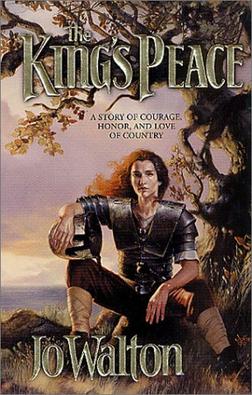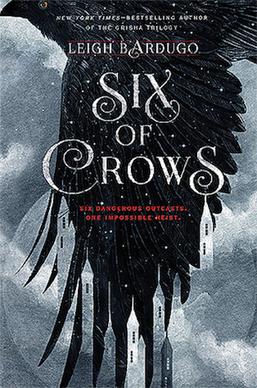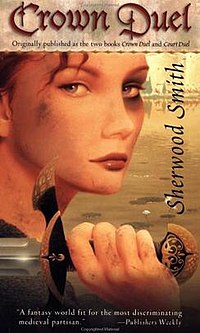Sarah Zettel is an American author, primarily of science fiction. Her first short story was published in Analog Science Fiction and Fact in 1991. Zettel's novels have won multiple awards, including the Philip K. Dick Award and the Locus Award for Best First Novel, and positive reviews from critics. Her first novel Reclamation was published in 1996 and her second novel Fool's War in 1997. She has written romance novels and mysteries under the pseudonym Darcie Wilde, and the novel Bitter Angels as C. L. Anderson.

Jo Walton is a Welsh-Canadian fantasy and science fiction writer and poet. She is best known for the fantasy novel Among Others, which won the Hugo and Nebula Awards in 2012, and Tooth and Claw, a Victorian-era novel with dragons which won the World Fantasy Award in 2004. Other works by Walton include the Small Change series, in which she blends alternate history with the cozy mystery genre, comprising Farthing, Ha'penny and Half a Crown. Her fantasy novel Lifelode won the 2010 Mythopoeic Award, and her alternate history My Real Children received the 2015 Tiptree Award.

The Grey King is a contemporary fantasy novel by Susan Cooper, published almost simultaneously by Chatto & Windus and Atheneum in 1975. It is the fourth of five books in her Arthurian fantasy series The Dark is Rising.
Kate Elliott is the pen name of American fantasy and science fiction writer Alis A. Rasmussen.

The Dark Is Rising Sequence is a series of five contemporary fantasy novels for older children and young adults that were written by the British author Susan Cooper and published from 1965 to 1977. The first book in the series, Over Sea, Under Stone, was originally conceived as a stand-alone novel, and the sequence gets its name from the second novel in the series, The Dark Is Rising. The Dark Is Rising Sequence is used as an overarching title in several omnibus, boxed-set, and coordinated editions; but the title of The Dark Is Rising is also used for the whole series.

Eddard "Ned" Stark, known as The Quiet Wolf, is a fictional character in the 1996 fantasy novel A Game of Thrones by George R. R. Martin and Game of Thrones, HBO's adaptation of Martin's A Song of Ice and Fire series. In the storyline, Ned is the lord of Winterfell, an ancient fortress in the North of the fictional continent of Westeros. Though the character is established as the main character in the novel and the first season of the TV adaptation, a plot twist involving Ned near the end of the novel and the end of the first season shocked both readers of the book and viewers of the TV series.
Sherwood Smith is an American fantasy and science fiction writer for young adults and adults. Smith is a Nebula Award finalist and a longtime writing group organizer and participant.

Robin McKinley is an American author best known for her fantasy novels and fairy tale retellings. Her 1984 novel The Hero and the Crown won the Newbery Medal as the year's best new American children's book. In 2022, the Science Fiction and Fantasy Writers Association named her the 39th Damon Knight Memorial Grand Master in recognition of her significant contributions to the literature of science fiction and fantasy.
The fantasy of manners is a subgenre of fantasy literature that also partakes of the nature of a comedy of manners. Such works generally take place in an urban setting and within the confines of a fairly elaborate, and almost always hierarchical, social structure. The term was first used in print by science fiction critic Donald G. Keller in an article, The Manner of Fantasy, in the April 1991 issue of The New York Review of Science Fiction.

High Deryni is a historical fantasy novel by American-born author Katherine Kurtz. It was first published by Ballantine Books as the sixty-first volume of the celebrated Ballantine Adult Fantasy series in September, 1973, and has been reprinted a number of times since. A revised and updated edition of the novel was released in 2007 by Ace Books. High Deryni was the third of Kurtz' Deryni novels to be published, and the final book in the Chronicles of the Deryni Trilogy. The next Deryni book to be published was Camber of Culdi, which details events that occur two centuries before High Deryni. However, the internal literary chronology of events in the Deryni series is continued in The Bishop's Heir.

Inda is a fantasy novel by Sherwood Smith, published in 2006. It is the first installment in a quartet of books which act as an historical prequel to Smith's other books set in Sartorias-deles, the world which she has been "writing about since [she] was eight years old". Inda's story takes place in the southern hemisphere of this planet.

The Fox is a 2007 novel by Sherwood Smith. It is continues the story of the fictional protagonist Inda.

Senrid is an original fantasy novel by Sherwood Smith published in May 2007 by Norilana Books, reissued by Book View Café

The King's Peace is a fantasy novel by Welsh-Canadian writer Jo Walton, published by Tor Books in October 2000. The first of Walton's published novels, it is also the first of three "Sulien" novels. It was followed in 2001 by a sequel, The King's Name, and in 2002 by a prequel, The Prize in the Game. The novels are a reinterpretation of the story of King Arthur.

A Stranger to Command (2008) is a fantasy novel written by Sherwood Smith. It was written as a prequel to her first published work that takes place on the actual Sartorias-deles, Crown Duel.

Throne of Glass is a high fantasy young adult novel series by American author Sarah J. Maas, beginning with the entry of the same name, released on August 2, 2012. The story follows the journey of Celaena Sardothien, a teenage assassin in a corrupt kingdom with a tyrannical ruler, the King of Adarlan. As the tale progresses, Celaena forms unexpected bonds and uncovers a conspiracy amidst her adventures. The series concluded with the eighth book in October 2018.

Lady of the Forest: A Novel of Sherwood is a 1992 historical fiction novel by American author Jennifer Roberson. A re-telling of the Robin Hood legend from the perspective of twelve characters associated with the legend, the story centers around English noblewoman Lady Marian FitzWalter's encounters with Lord Robert of Locksley and his scheming rival the Sheriff of Nottingham amid the backdrop of Prince John's schemes – he aims to increase his own wealth and power at the expense of post-Conquest England and his brother, King Richard.

Leigh Bardugo is an American fantasy author. She is best known for her young adult Grishaverse novels, which include the Shadow and Bone trilogy and the Six of Crows and King of Scars duologies. She also received acclaim for her paranormal fantasy adult debut, Ninth House. The Shadow and Bone and Six of Crows series have been adapted into Shadow and Bone by Netflix, and Ninth House will be adapted by Amazon Studios; Bardugo is an executive producer on both works.

Six of Crows is a fantasy novel written by the Israeli–American author Leigh Bardugo and published by Henry Holt and Co. in 2015. The story follows a thieving crew and is primarily set in the city of Ketterdam, which is loosely inspired by Dutch Republic–era Amsterdam. The plot is told from third-person viewpoints of eight different characters.

All the Birds in the Sky is a 2016 science fantasy novel by American writer and editor Charlie Jane Anders. It is her debut speculative fiction novel and was first published in January 2016 in the United States by Tor Books. The book is about a witch and a techno-geek, their troubled relationship, and their attempts to save the world from disaster. The publisher described the work as "blending literary fantasy and science fiction".

















